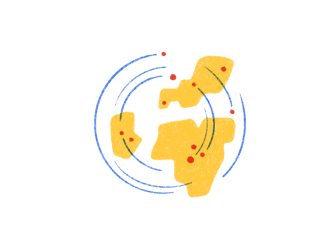Today’s companies have the opportunity to build the future we want to work in. This a future with a calmer, more balanced, and more fulfilling way to work and live. This is a future with remote work.
Technology allows us to work from wherever we want. We can log on to computers from a home office or coffee shop anywhere in the world, as long as we have an internet connection. And, despite some resistance to a new mode of work where teams are distributed, more companies are opting out of a traditional central office and building remote teams.
Now that teams have advanced tools like team communication apps, video chat, and project management software, team members are able to work together regardless of their location. As a result, companies can tap into talent pools around the world and employees can work from wherever they desire without having to relocate to expensive metropolitan areas.
We’re living this reality at Doist. We’re a remote team of 68 people in 25 different countries, and 52 cities. There are still people on our team who have worked for the company for years who haven’t met anyone at the company in person.
Although remote work offers many advantages, some argue that nothing can replace working together face to face. While we recognize that in person interactions are important – perhaps essential for building friendship and comradery – we believe that the future of work is remote.
Remote work has only recently emerged as a viable option for growing companies. But in that short time, more and more companies are opting to take advantage. Why are we seeing such a rise in remote work?
 Technology makes remote work possible
Technology makes remote work possible
Remote work simply wasn’t possible before. In order to work together and collaborate, workers had to exist side-by-side in person. This was true on a farm, in factories, and even in more modernized standard offices.

Head of Operations, WeWorkRemotely
Better communication technology is obviously one of the main drivers of the rise of remote work. There really isn't any barriers to starting a remote friendly company now -- you just need a computer, stable wifi, a team productivity/project management app and you're off to the races.
Now, technological innovation and globalization enables citizens across the world to acquire in-demand skills and work anywhere. Not only do people have access to education through the rise of online learning, they can also connect with others virtually once they’re in the workplace. This means someone from Nairobi can have a collaborator in New York City.
Specific tools meet remote needs
As technology has gotten better, it’s also evolved to specifically meet the needs of remote workers. Innovation in the space, particularly in cloud infrastructure, has led to major advancements in communication, finance, project management, and much more.
Here are a few of the popular tools that remote companies use to communicate effectively, collaborate together, and ultimately be productive despite being spread across multiple locations.
| Tool | How Tool Supports Remote Work |
|---|---|
Twist is a communication app for teams who want a calmer, more organized, more productive workplace. Twist limits chaos and helps remote teams stay on topic. | |
Google Docs allows teams to collaborate on written documents, providing a seamless experience for drafting, editing, and refining documentation - whether that’s company policies or blog posts. | |
Dropbox allows teams to upload and share files in a central place, giving remote teams access to what they need, wherever they are. | |
Zoom offers robust video chatting software with high quality video and clear audio. This allows team members to meet and collaborate face-to-face across borders. | |
Transferwise is an easy way to send money abroad, making it simple for companies to pay remote workers no matter where they live. | |
GitHub allows developers and engineers to host, review, and collaborate on code, as well as other projects. | |
Todoist keeps track of tasks and projects in one central place. It syncs across devices so your work can always be accessed. |
 Why teams are turning to remote work
Why teams are turning to remote work
Technological innovation has made remote work possible, but that doesn’t explain why it’s attractive to employers across the globe. Remote work is more than just a future goal. Companies and individuals are already taking advantage of the opportunities. In 2017, the number of remote workers had more than doubled from a decade earlier, according to GWA and FlexJobs .The report also states that in 2017, 40% more U.S. employers offered flexible workplace options than they did in 2010.
The downsides of the modern workplace coupled with difficulties finding top talent have made remote work enticing to both employers and their teams.
In 2019, Buffer found that 99% of existing remote workers would like to work remotely, at least some of the time, in their careers. Many cited a flexible schedule (40%) as the biggest benefit to remote work, followed by the ability to work from any location (30%).
But going remote offers more than an escape from modern workplace challenges– it has become a competitive advantage. Remote teams are often happier, healthier, and more productive. Because of the need for deliberate communication, these teams are often more in sync than those that work in a traditional office.
Remote work is no longer an alternative. For many companies, it’s the first choice.
One of the biggest reasons why remote work has become so attractive is because of the inherent downsides of the in-person workplace. Open work spaces are often distracting, preventing workers from engaging in high priority activities. High costs of living in tech hubs result in long commutes, which results in diminished work-life balance.
Constant distractions prevent “deep work”
Many find that open work spaces– which are meant to be collaborative– are distracting. Constant interruption makes it more difficult for team members to engage in “deep work,” hampering productivity. On average, employees who do the majority of their work on computers are distracted once every ten and a half minutes.
It’s not just productivity that takes a hit when workers are constantly interrupted. Researchers have found that people attempt to compensate for all these distractions by working faster and faster, leading to “more stress, higher frustration, time pressure, and effort.” In short, the modern office environment makes it difficult for team members to be productive.
“Parse.ly engineers report that the biggest benefit of the fully distributed team is being able to really focus on one’s work, and thus produce great things. Almost everyone on our team used to work in an office environment where it was not uncommon to be interrupted throughout the day by the people sitting next to you.” - Andrew Montalenti, Parse.ly, The ‘How and ‘Why’ of Parse.ly’s Fully Distributed Team
One of the biggest distractions plaguing office workers today is real-time communication in the form of always-on chat tools like Slack and HipChat. Although these tools can help in-person and remote teams build comradery, they can also become addicting.
At Doist, we found that using Slack was useful for checking in on quick things, but was more often used for shallow, disorganized conversation that distracted us from the productive work that moved our company forward. That’s why we created Twist, which is centered around threaded and asynchronous communication.
Rising cost of living and long commutes
It’s no secret that cities with healthy job markets, like San Francisco, Boston, and Seattle, have become prohibitively expense. The rising cost of living has given way to long, draining commutes that impede quality of life.

Customer Support Specialist, Doist
I no longer need to rush in the morning to catch a train/bus. I do not need to suffer in a very crowded train rides of Tokyo. I do not need to worry or feel anxious about being on time when there is a delay (trains and buses). I am more in control of my schedule (e.g. when to wake up, eat, work, play, cook etc). On the other hand, you need to be disciplined because no one is managing you.
It’s not uncommon to spend over two hours a day just traveling to and from work. In an article called “A 2:15 Alarm, 2 Trains and a Bus Get Her to Work by 7 a.m.”, the New York Times chronicled the 6-hour roundtrip commute of one San Francisco public servant who could no longer afford to live anywhere near her workplace. Remote work offers an alternative to this stark reality.
Workers are interested in trading in long commutes for better work-life balance, and many would take a pay cut in order to do so. According to research conducted by Qualtrics and Accel Partners, 76% of millennials would take a 3% pay cut to work for a company that offered flexible office hours. Andrew Pentis of Student Loan Hero shared his story of why he took a $12,000 pay cut, citing the ability to work from any location as one of the biggest perks.

CEO, Remote
Remote work allows everyone to live a better life. You don't have to commute, so you have more time to spend on things outside of work. Remote work also forces teams to work more flexibly. That means that for most teams, rigid work times are a thing of the past– you can shop for groceries when it’s convenient for you, and take care of your loved ones when they need it. Workers can also work at the times that suit them best, rather than what their employer prefers. Together, this means that everyone is happier and does better work.
A desire to unlock worldwide talent
Although there are more skilled workers than ever before, it’s become difficult to find and keep top talent, especially in competitive tech hubs like San Francisco and New York City. According to data compiled by LinkedIn, the average tech employee’s tenure at a given company is a mere 2.1 years. This lack of retention is costly. SHRM has estimated that it costs a company roughly 6 to 9 months of an employee’s salary to replace them.
Talent is distributed, opportunity is not. Remote work offers the opportunity to unlock the world’s genius. Rather than focusing on hiring efforts in one competitive area, where employees are likely to jump ship for a new opportunity, companies can tap into skilled workers from all over the world without competing with expensive commercial centers.
“When it was time to start hiring, I tried to contain my initial push for developers to the area surrounding Newport. Unfortunately, I couldn’t find anyone with the skills, experience, and intangibles that I was looking for. As soon as I opened up my search to include the rest of the country, I found the right employees very quickly. Our first two engineering hires were made within the next few weeks, and they’re still with Groove today.” - Alex Turnbull, CEO & Founder of Groove, The Pros & Cons of Being a Remote Team.
This allows companies to build teams that are heterogeneous, made up of different kinds of people with a variety of ideas and perspectives. Devin Bramhall, Director of Marketing at Animalz, believes that having diverse employees leads to a larger client base, as well as more interesting projects. “Because our employees are spread out, it's easier to service customers across the globe, which means we have a larger potential client base,” said Bramhall. “This also leads to more diverse projects we get to work on and companies we collaborate with.”
The remote advantage
Remote work is a competitive advantage. That’s because it’s often synonymous with better work-life balance, which leads to happier and healthier teams. Additionally, remote companies can hire the best possible talent they can find without restrictions on geography.

Co-founder EmberTribe
We adopted a distributed model from the beginning. In fact, my co-founder is based in North Carolina and I'm in greater Boston, and neither one of us felt like it made sense to build a team around one location at the exclusion of the other. But more importantly, our company is only as strong as the players on our team and we didn't want to have a geographical constraint for hiring. We say the distributed model lets us hire the best people, who do their best work while living their best lives.
Remote teams have become very good at communication, as well. Many remote companies default to transparency and trust due to the fact that they don’t have the ability to stop by a team member’s desk to hash issues out in person.
At Doist, almost all communication is public and accessible to the whole team via Twist. Because the team is fully remote, there’s a huge emphasis on ensuring that team members are kept in the loop.
Similarly, Stripe has an innovative email transparency system, where the company makes emails transparent to everyone.
The team at Automattic uses a P2 Wordpress theme to document conversations, so that they're searchable and visible to everyone on the team.
Employees at Remote are deliberate about where information is kept, and write everything down to ensure that there is a single source of truth for every bit of information.
There’s cost savings, too. Not only does remote work reduce employee turnover (which quickly gets expensive), it also has much less overhead. Companies do not have to shell out for the high costs of office space.
Finally, there are inherent positive environmental impacts in shifting to remote work. Because remote team members usually work from home, they aren’t getting into their cars every day and polluting the atmosphere. This is significant, as transportation costs make up 29% of greenhouse gas emissions in the U.S. According to a study by FlexJobs and GWA, 7.8 billion vehicle miles were not traveled and $980 million was saved on oil costs thanks to remote workers.
 Different types of remote work
Different types of remote work
Remote work is not one-size-fits-all. Some companies have a traditional office but offer remote work policies that allow employees to choose to work remotely 1 or 2 days per week.
On the other end of the spectrum, some companies operate with a fully-distributed team, meaning that virtually every team member works remotely. In these models, there’s often no official headquarters.
Buffer recently surveyed close to 2500 remote workers to find out their companies stances on remote work.
They found that 40% of survey respondents have part of their team working outside the office, while part of their team works in the same office.
They also found that 31% work for companies that are fully remote, while 16% can work from home as needed.
Office-based with remote flexibility
Many companies, especially those that have been around for several years, have a traditional office where employees come to work every day. However, many of these companies are embracing remote work. They don’t see it as an end-all, be-all solution but as a way to offer more flexible work arrangements to employees.
The degree of remote flexibility is heavily dependent on the company. Here are a few ways that remote work might be integrated into an established office-based environment:
Everyone must come into the office but is able to work remotely one day per week. Sometimes, there is an established day, such as Wednesday, where everyone works remotely.
Remote work arrangements are assessed on a case-by-case basis depending on an individual employee’s situation.
Almost everyone works at the headquarters with just a few employees who are given the ability to work remotely.
Many large companies, such as AOL and American Express, have introduced flexible work policies to accommodate the growing interest in remote work. On the Amazon careers site, there’s an entire page dedicated to remote career opportunities.
Partially remote teams
Many companies take their approach to remote work a step further and create teams that are partially remote. Usually this means that some members of the team work remotely, while others work from a central headquarters.
This may seem like the best of both worlds, but it can be challenging to make remote workers feel as though they are part of the team. Often, they may be left out of the loop or simply have a harder time building comradery with coworkers. Even so, this is a flexible model that works for a variety of companies.
Examples of partially remote teams include FogCreek Software, Angelist, Shopify, and Atlassian. Shopify is headquartered in Canada with offices in Ottawa, Toronto, Montreal, and more. But it also has offices in San Francisco, Shenzhen, Singapore, and a host of other cities. On top of that, Shopify has many team members that work fully remotely.
For partially remote teams, it’s important to keep remote workers and office workers on equal footing:

Co-Founder and CTO, HashiCorp
For the SF Office, we have a relatively small footprint, only < 20% of staff are there. In general, the teams there are very centralized (HR, legal, finance, IT). The teams that are more decentralized have very few people in the SF office. That said, most of the time meetings in SF also have a zoom call attached and all the conference rooms have an AV setup for that. We try to think about "remote first" and stick to that even in the office.
Remote team that is co-located
A remote team that is co-located has team members that work remotely, usually on a full-time basis. However, co-located teams usually work in the same city or region. In this model, leaders prioritize hiring team members in certain locations, especially based on time-zones.
Co-located remote teams can get work done in a synchronous way as their work hours will overlap. They’re unlikely to be relying on team members that are on the other side of the globe. This not only makes it easier to communicate on a daily basis, but also makes it easier for the team members to get together for occasional off-sites.

Editor-in-Chief, Chatra
The country doesn’t really matter for us, we’re really looking for the best possible candidate. As for the timezone, since the majority of our team is based in Europe, it’s important for us that at least some (preferably half) of the working day of a person from a different timezone overlaps with the time when the majority of team members are online. It keeps the team connected, and helps us exchange information more effectively.
Examples of other co-located teams include Aha!, Webflow, and The Taproom.
Remote team that is fully distributed
Finally, there are companies that have remote teams that are fully distributed. These teams are spread across multiple time zones and often include people from all over the world. Some companies may consolidate certain functions in the same time zone, while others will be more flexible.
With this option, communication needs to be thoughtful because it’s difficult for certain team members to work together at the same time. Asyrcnrous-first communication is often the top choice of fully distributed teams. However, it also allows companies to tap into world-wide talent. There are no barriers on who they can hire.

Director of Marketing, Animalz
Animalz has 38 full time remote employees living across the globe. Locations include US (east coast, west coast, even Hawaii!), UK, Canada, and Spain. There are some logistical challenges with things like benefits, compensation, and compliance that can be challenging, but if you hire a dedicated people ops person or staff, you’ll be set-up to navigate them.
Examples of fully remote companies include Doist, Buffer, Zapier, InVision, Automattic, and HotJar.
 Critiques of remote work
Critiques of remote work
Although remote work has some obvious advantages, there are challenges, as well. Many companies have dipped their toes into remote work, only to realize that it’s better to have everyone in the office.
In 2017, IBM, which had been a pioneer for remote work throughout the 1980s and 1990s, asked thousands of employees to come back to a traditional office. Company leaders believed that working together in person would foster more innovation.
Similarly, Marissa Mayer, CEO of Yahoo, controversially banned remote work in 2013. Shortly after joining the company, Mayer noticed a general lack of productivity and comradery, which she believed was enabled by the company’s liberal remote work policy. Even so, it seems that Yahoo employees still work remotely. According to a Yahoo employee who spoke with the Huffington Post in 2015, many employees still occasionally work from home, and some don’t have a desk at the office.
Communication is a constant challenge, especially when workers are spread across time zones. For example, when Juliana Casale worked as Head of Marketing at Crazy Egg, a fully-remote company with no central headquarters, she noticed that projects took twice as long as they did when she worked in a traditional office:

Former Head of Marketing, Crazy Egg
A big challenge was projects taking twice as long to complete because of time zone differences. My designer was in Australia and my developer was in the Philippines, so if I outlined an ask, I had to be very specific about why we needed something, what I wanted, and what examples already existed. If there was a question, I wasn't online at the same time to answer it. I had to become adept at providing detailed instructions, and mocking up what was in my head.
Mental health challenges like loneliness and isolation can take a toll on workers, as well, since they’re working in an environment without other people.

Director of Marketing, Animalz
Remote work gives you freedom, and with that freedom comes the burden of loneliness. Working from home means, in many cases, that you work alone. The challenge that presents for us is that it can turn some candidates away. We’ve lost people because they realized remote work isn’t for them. Not many, but it does happen, and it’s something companies should prepare for.
Here are some other common critiques and caveats of remote work:
Technical issues. We live in a world of instant messaging and video chat, but technical snafus still arise. Spotty wifi connections, dropped calls, misbehaving software, and other issues routinely arise. Although these issues aren’t usually frustrating on a one-off basis, they can grate on team members when they occur day after day.
Harder to build company culture and foster comradery. When people work together in person, they spend time getting lunch, coffee, and simply catching up. Working remotely makes it harder to foster this comradery, which makes it more challenging to build a tight company culture where team members truly have each others’ backs.

Head of Publications, Toptal
I still don’t think we’ve fully solved the culture equation. Companies have augmented remote interaction with in-person meetups and a suite of collaboration tools, but I still think we haven’t found a way to build relationships across remote teams effectively. I think the biggest gap there is that most solutions try to copy and paste what works in an office, instead of coming up with new solutions for this new workforce.
Difficulty unplugging after work. Because most remote workers opt to work from home, they may struggle to separate work time from personal time. According to a survey from Buffer, unplugging after work is employees’ biggest struggle with working remotely. Similarly, a report from the United Nations International Labour Organization found that employees who work outside of regular office hours are more likely to work long hours at an intense work pace.
Rise in loneliness due to isolation. Isolation, anxiety, and depression are significant problems when working remotely, and we must figure out ways and systems to resolve these complex issues.
Difficulty collaborating, especially across time zones. Because remote teams employ people from around the world, time zones can be a conflict. It can be difficult to schedule meetings, especially those with the entire team, when one person’s working hours are during the middle of the night for someone else.
Constant interruptions at home. Many remote workers say that they’re distracted by their home environment. Not only are they often “on call” to answer the doorbell, but they may also struggle to convince family members that they’re truly at work. This leads to interruptions that hamper productivity.
Choosing to go back to an office environment becomes nearly impossible. Once your team is fully remote, it becomes nearly impossible for a company to decide they want to consolidate the team at a central headquarters. It’s easy to become a more remote-friendly company, but it’s much more challenging to get a distributed team back in a central location.
Taking remote work challenges in stride
Remote work isn’t perfect. However, companies are finding innovative ways to meet its challenges. By prioritizing good communication, limiting interruptions, and encouraging employees to maintain work-life balance, team members are better set up to be productive while working remotely.
Building a company build on trust. It’s important to build remote teams on a foundation of trust. In the absence of physical presence, relying on trust will overcome some of the challenges associated with remote work.

Senior Director of Brand, Loom
In my experience if there's not a very explicit exclamation of trust, there can be a tendency to be "always on". For example, I've seen a lot of Slack messages to the tune of "just taking the dog out for a walk, I'll be on Slack" or "popping out to grab lunch, back in 10 minutes". It feels that unless you are accounting for what you're doing / working on every second of the day, that there's a feeling that maybe someone might perceive you're slacking off. This part for me definitely triggered some anxiety I have around always proving my value and I found I was replying to emails and slack messages more in the evenings and the weekends.
Limiting interruptions. To preserve focus and minimize the constant interruptions from chat tools, make it clear that team members don’t need to respond in real-time. At Doist, we default to asynchronous communication and use Twist as our communication tool of choice.
Encouraging work-life balance. Encourage team members to maintain hobbies and side-projects and spend evenings and weekends with family and friends. Remote workers run the risk of burnout because there’s no clear division between “life” and “work”.

Former Head of Marketing, Crazy Egg
When I first started working remotely, I tried to work from home, but it always felt like a sick day, so I got a membership at a co-working space nearby. My commute was only 15 minutes, but having a routine, putting on real clothes and being around other people really made a difference.
Building a Remote first team. If part of your team is remote and the other is office-based, ensure that you’re not creating in information hierarchy with remote workers at the bottom. Put processes in place that ensure that remote colleagues have the same access to information and opportunities as their office-bound counterparts.

Senior Director of Brand, Loom
Companies that have both remote and location based employees should adopt a "remote first" mentality. Always making sure there is video-conferencing available and trying to avoid hallway decision making. Fully remote companies should be very specific about addressing potential pain points in remote work rather than accepting as fact that remote automatically is better than a centralized workforce. That's the biggest issue I've seen. That companies will blindly accept the notion that "remote is the future of work" without actually doing the work that it takes to ensure it works for everyone.
Set up systems for rewards and recognition. On a remote team, where new team members may feel lonely or isolated, ensure processes are in place to acknowledge great work. Use your team chat app to give your team members shout-outs and recognize their contributions on a successful product release, a well-received blog post, or going above and beyond for a customer. Alternatively, consider employee recognition and rewards tools. Apps like [Bonusly](https://bonus.ly/), help teams celebrate everyday contributors and key milestones through peer-to-peer micro-bonuses, so employees can recognize and publicly praise their colleagues for work they've done well.
Remote Retreats. Companies with team members around the world often opt to meet for retreats where everyone gathers in one location. Doist [plans an annual retreat each year](https://open.buffer.com/remote-work-retreats/), as does Buffer, a fully-remote team.

Content, Toggl
In-person retreats are incredibly important for Toggl. Remote work is great, but we believe it can’t be done effectively without some for of face-to-face connection between coworkers. Spending in-person time with coworkers builds connections, empathy, and helps us better understand how we can work together. During retreats, we spend equal time getting to know our coworkers and building connections, as we do figuring out how we can better Toggl.
 Remote work is the future of work
Remote work is the future of work
A distributed team is not a perfect solution to today’s workplace challenges, but it certainly offers an alternative for companies and workers that want to take advantage of its benefits.

Head of Operations, WeWorkRemotely
I think remote work, or the option of working remotely, will become the standard. It takes time for the perception of work to change away from the "you need to be in the office to be considered working" mentality to a more outcome driven approach. It will require management to be better, and all of us in the space to collaborate and help solve some of the problems of isolation when working remotely. But we'll get there. The benefits of remote work vastly outweigh the negatives.
There’s clear evidence that remote work is here to stay. Here are a few examples:
Zapier, a software company based in San Francisco, now offers up to $10,000 for team members who are willing to leave the expensive Bay Area to work elsewhere.
Vermont made headlines when Governor Phil Scott signed a bill that pays remote workers to move to the state. Anyone who moves to Vermont and works remotely is eligible to receive $10,000 from the state.
Estonia is developing a digital nomad visa which will support location independent workers. This visa will allow anyone who works remotely to reside in Estonia for 365 days.
There are more successful companies with fully remote teams than ever before. Doist, Buffer, Zapier, InVision, and Automattic are all thriving companies that have transitioned to a fully remote model.
As technology becomes more and more advanced, remote work will become even more seamless. By 2020, it is expected that 50% of the workforce will be working remotely.
At Doist, we’re confident that remote work is not a fad. As the years pass, more companies will grow distributed teams and more workers will demand to work remotely. In a world where working from anywhere is possible, it’s an exciting time to grow a company.

